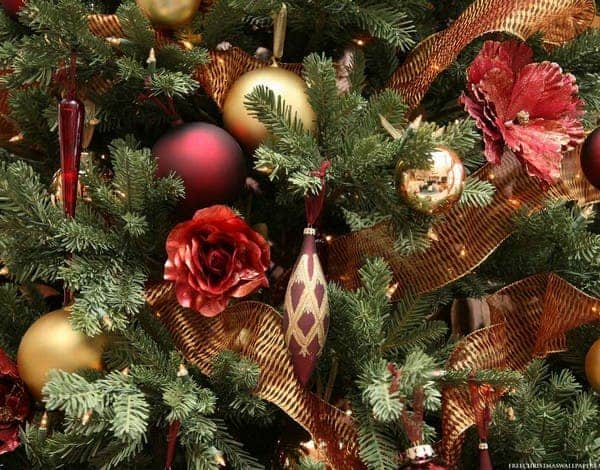Every year, the Christmas tree debate returns: Is it better to cut down a natural tree for a short-lived holiday display, or use an artificial one made from non-recyclable plastic? The answer is not as clear as you’d think and depends heavily on how the trees are grown, manufactured, or disposed of. Let’s dig into the facts and explore more sustainable alternatives.
Let’s look at some specifics.
Artificial Christmas Trees

Typically made from PVC (polyvinyl chloride) plastic, these trees are designed for convenience but come with a hidden environmental cost. As a Kansas State University researcher described, the belief that artificial trees are eco-friendly is “an urban myth.”
Artificial Christmas trees have come a long way — some look so real you’d need a close inspection to tell the difference. Usually, they’re made from PVC plastic and come in the shape of a small fir although there are also other, more creative alternatives. Despite undeniable progress, however, artificial trees often actually do more harm to the environment than cutting natural trees; in other words, the idea of artificial trees being eco-friendly is, as a researcher at Kansas State University put it, “an urban myth”.
A 2011 peer-reviewed study found that a two-meter artificial tree produces around 40 kilograms of CO₂ emissions, more than 10 times the carbon footprint of a real tree that’s later burned. This discrepancy largely comes from the materials used and the production process. PVC is derived from petroleum, making it non-renewable and non-recyclable.
The manufacturing process also releases harmful carcinogens like dioxins, ethylene dichloride, and vinyl chloride. Additionally, lead can sometimes be used to produce needles, posing significant health risks. Vacuuming around the tree can spread tiny lead particles in the air, which creates an inhalation danger.
For an artificial tree to be environmentally comparable to a natural tree, you’d need to reuse it for at least 10 years. Unfortunately, most people only keep their fake trees for around 4 years.
We also looked at the matter of transportation, because these artificial trees are brought from far away (typically China), whereas real trees would be brought from much closer. However, in the grand scheme of things, this doesn’t make much of a difference.
“The reality is that the long distance transport from China is pretty efficient,” says Laura Morrison, a Senior Consultant at PE International who investigated the matter.
“Real” Christmas Trees
Natural Christmas trees — usually firs, pines, or spruces — have been a tradition since 16th-century Germany, but their history predates Christianity. Early northern cultures like Vikings used evergreen branches to ward off spirits during winter.
Yet, Christmas trees have become the undeniable, global symbol of Christmas.
Annually, around 33–36 million trees are sold in the U.S. and 50–60 million in Europe. While cutting down millions of trees may can obviously be harmful, these trees are cultivated as crops and often replanted. Christmas tree farms can provide habitats for wildlife and are carbon-neutral. However, emissions from transportation and farming practices still contribute to their environmental impact.
Natural tree growers contend that artificial trees are more environmentally harmful than their natural counterparts, but trade groups such as the American Christmas Tree Association claim the exact opposite — so you can’t really rely on either of their claims considering their obvious bias. So what does the science say?
Live trees are typically grown as a crop and replanted in rotation after cutting, often providing suitable habitats for wildlife. While poor management can lead to poor habitat and soil degradation, Christmas tree plantations are generally decent habitats.
Another drawback to living trees is that you only use them for a short while before throwing them away. Sadly, even though they are biodegradable and highly recyclable, Christmas trees are sometimes simply thrown away.
Recycling natural trees into mulch or using them to combat erosion can mitigate this impact. Unfortunately, many trees end up in landfills, releasing methane as they decompose.Real trees are also carbon-neutral, though emissions can occur from farming activities and transportation. They are also more expensive than artificial trees since you need to purchase a new one every year.
The verdict: which Christmas tree is better?
Both natural and artificial Christmas trees have environmental drawbacks. Artificial trees generally have a higher negative impact due to their energy-intensive production process, pollution from PVC plastic, and potential health hazards. On the other hand, cutting down real trees — even if they are recycled — comes with its own ethical concerns. Letting these trees grow instead would provide better habitats, increase carbon sequestration, and enhance landscapes.
If you want a sustainable option, it helps to compare thoughtfully. Artificial trees can have a lower overall impact if they’re reused for at least 10 years, though most people replace them after just 4 years. Natural trees are a better choice if they’re sourced locally and sustainably, as transporting them long distances increases their carbon footprint. If you’re buying from a local sustainable farm, that also makes a difference; if you’re buying a non-PVC artificial Christmas tree, that’s also a factor. Compare the specifics.
Sustainable Christmas Tree Alternatives
Ultimately, the most eco-friendly choice might be skipping a tree altogether. Here are some ideas:
- Potted Christmas Trees: These can be planted after the holiday season, allowing you to enjoy the tree year after year.
- Rent a Tree: Some services offer live trees for rent, which are returned and replanted.
- DIY Alternatives: Get creative with wooden branches, recycled materials, or even fabric trees.
- No Tree: Decorate your home with natural branches, wreaths, or festive lights — no need for a full tree!
Ultimately, a better choice for the environment may be to use a natural tree that has been sustainably grown and harvested, and probably the best choice is to use a potted tree that can be planted after the holiday season. A potted Christmas tree can make for a sustainable Yuletide to remember, and it’s a good conversation starter too.
This is what science says. This Christmas, make a decision that aligns with your values — the environment will thank you!




